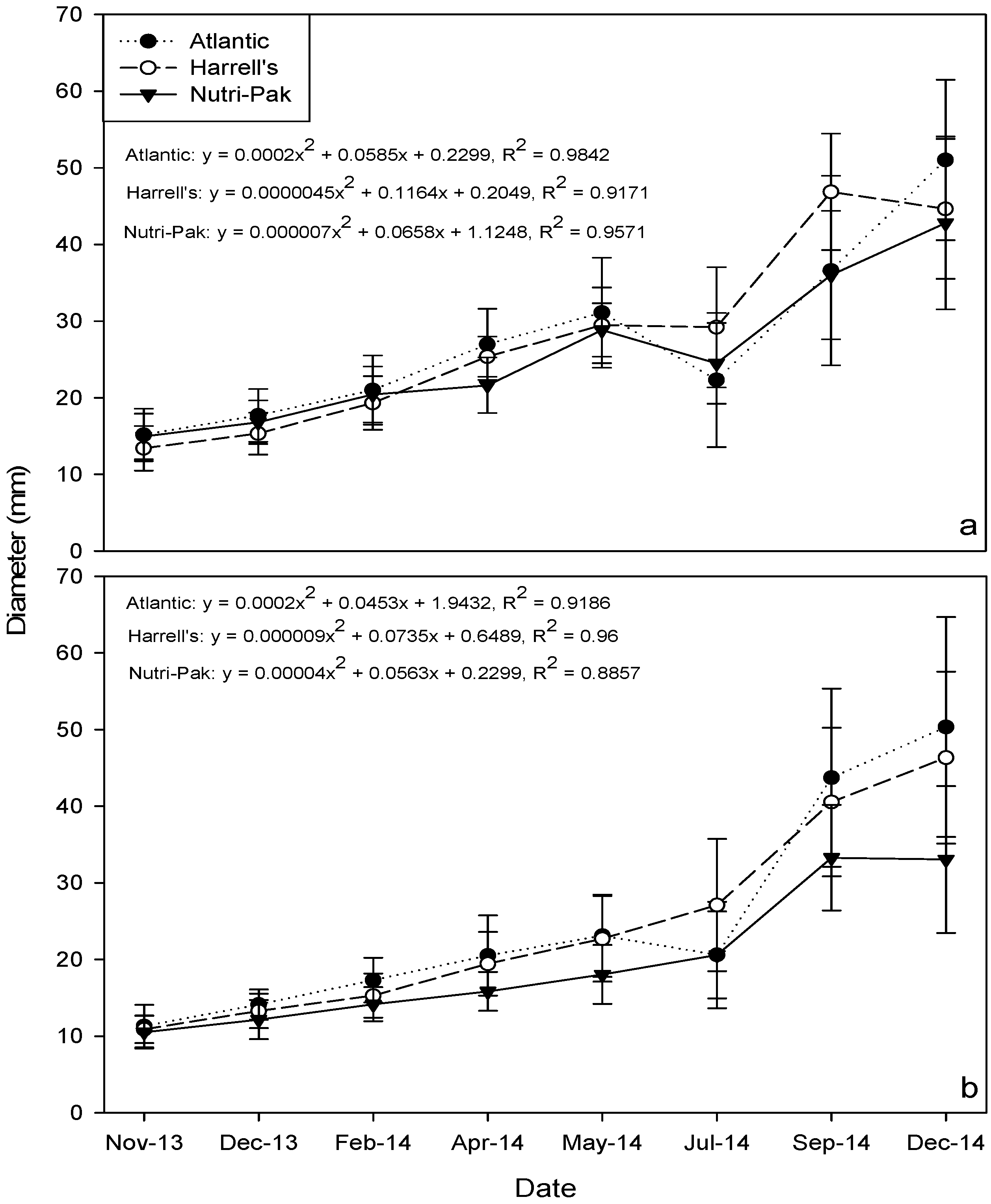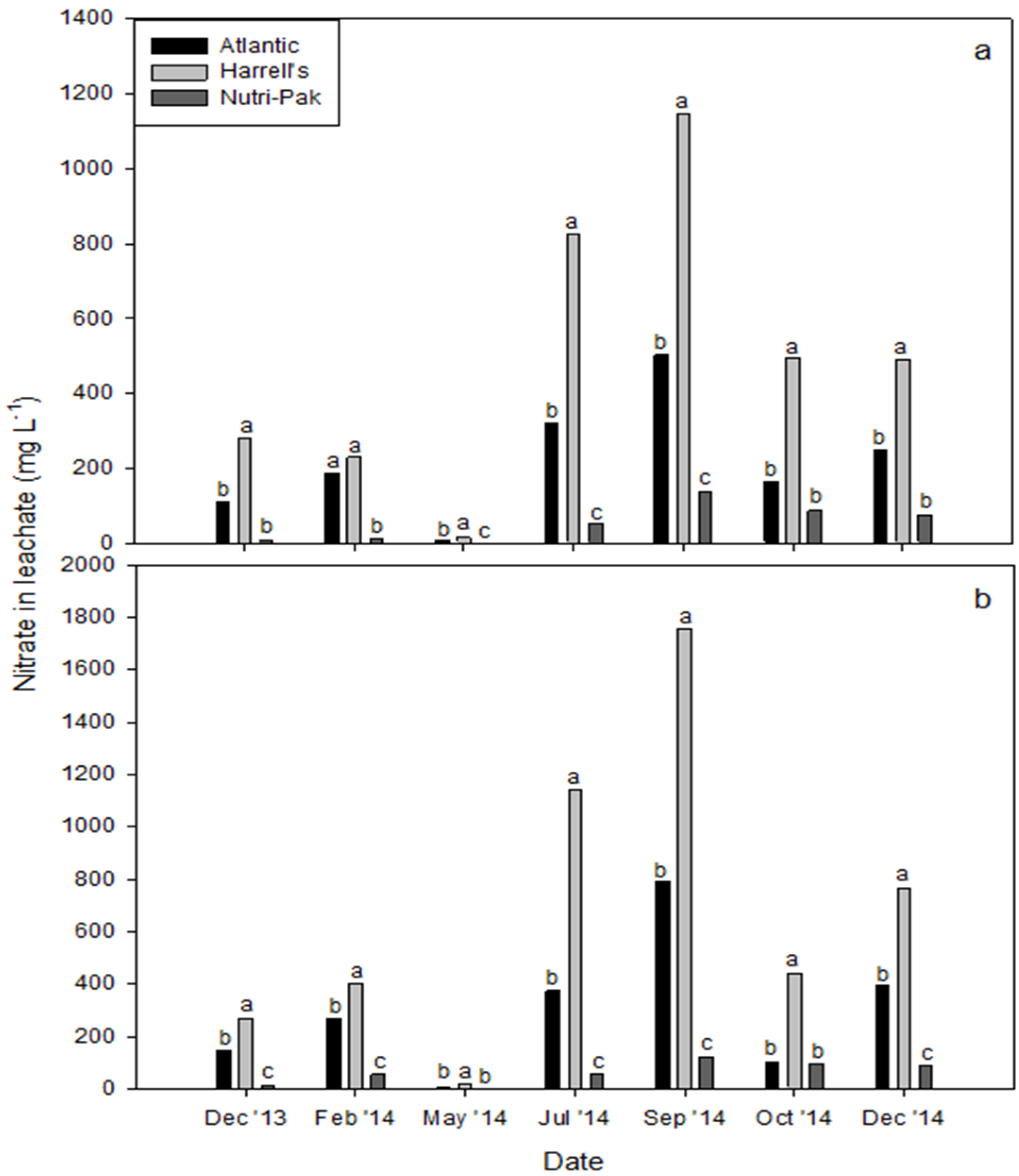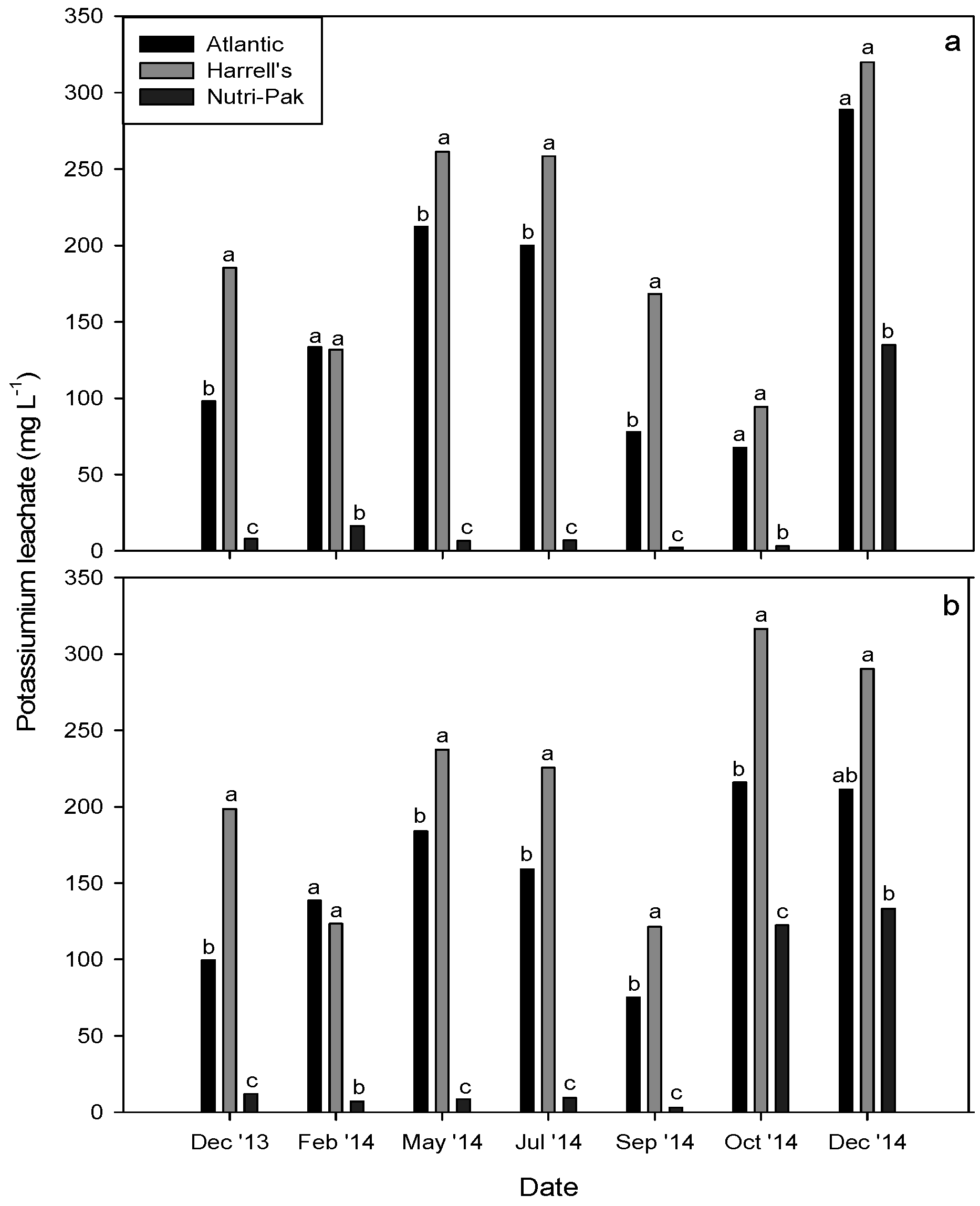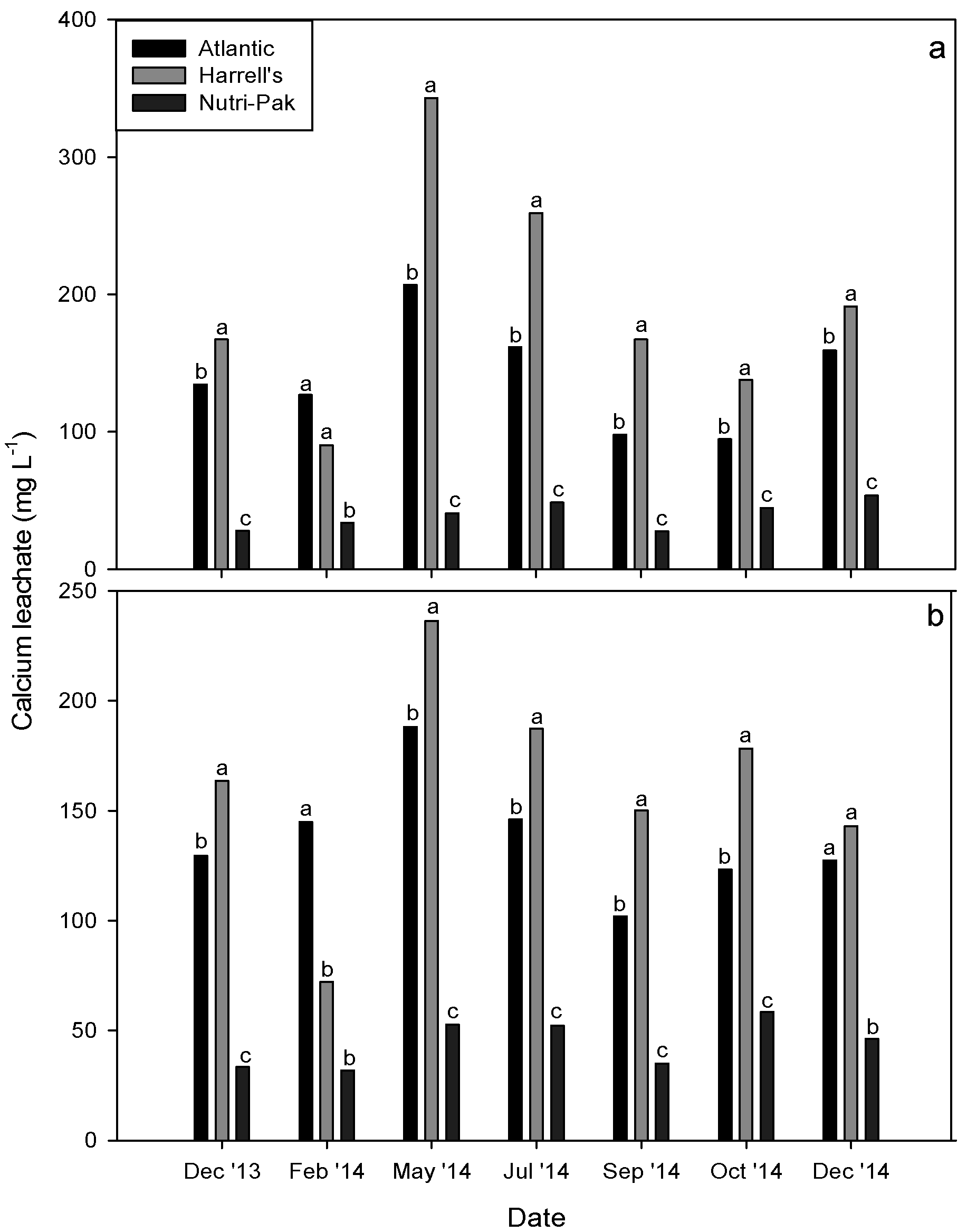1. Introduction
Palms are one of the most important ornamental plants in Florida landscapes. They are a major crop representing 9.5% of Florida’s nursery sales [
1]. There is a large diversity of palm species, well-suited to the sub-tropical climate of South Florida because of their tolerance of cool winter temperatures, seasonal rainfall, soil alkalinity, and resistance to pests and diseases [
2]. Normally, palms are considered low maintenance landscape plants but the palms growing in Florida landscapes are subject to numerous nutrient deficiencies, such as nitrogen, potassium, magnesium, manganese, and iron [
3]. Furthermore, with sandy soils and high rainfall, nutrient loss due to leaching is significant. However, for potted plants, nutrient loss by leaching is not as high because of the organic potting substrates with higher water holding capacity.
Elliott
et al. [
4] report that deficiencies of K, Mn and B can be fatal in palms. While K, Mg and Mn are more limiting in landscapes, N is the most limiting element in the container grown palms caused by insufficient N in the potting media and also because of the tie up of N by the organic substrate [
5]. Fertilizers having an analysis 8N-2P-12K-4Mg plus Fe, Mn, Cu, Zn, and B with 100% of the N, K, and Mg in controlled release form are recommended for the maintenance of palms in Florida [
3,
6]. Use of an effective controlled release fertilizer provides growers a convenience of application, reduced economic and environmental costs. Maintaining profitability without impacting the environment is a challenge faced by Florida container nurseries. One way to reduce the environmental contamination of nutrient runoff from nurseries is to manage irrigation according to plant daily water use, and loss due to transpiration and substrate evaporation [
7]. However, the most important thing is the right source, timing, rate and placement of nutrients.
There are multiple forms of fertilizers available for container grown palms, liquid, granular, palm special, foliar, and granular fertilizers. Over the years, nursery growers have used polymer coated controlled release fertilizers in the production of container grown plants. The goal of using controlled release fertilizers is to provide nutrient to plants as needed over an extended period of time. These fertilizers can provide higher nutrient use efficiently. However, most of the available “palm special” fertilizers are formulated for landscape or field nursery use and are not recommended for container palm production [
8] because the field and landscape soils are very different than the potting substrate.
The objectives of this study were to evaluate the effect of different fertilizers on nutrient leaching and plant growth parameters of two container grown palm species Chinese fan (Livistona chinensis) and Queen palms (Syagrus romanzoffiana), and to evaluate the cost of production of these two palm species.
2. Materials and Methods
We conducted two experiments to evaluate the effect of different fertilizers on nutrient leaching and plant growth parameters, one experiment on each of two palm species. Fertilizers used in this study were produced by different manufacturers, each with different release rates and coating technology. The fertilizers used were: Nutri-Pak (controlled release 12-4-12), Harrell’s (controlled release 12-4-12) and Atlantic (controlled release 8-4-12), the most commonly used palm fertilizer in South Florida. Nutri-Pak (JRP International, Inc., Fond du Lac, WI, USA) is a controlled release fertilizer in a micro-pore polyethylene packet. Moisture enters the packet through micro-pores located on both sides of the packet. Pressure caused by heat and vapor, releases the dissolved fertilizer through the same micro-pores and into the soil gradually providing nutrients to plants. Harrell’s (Harrell’s, Lakeland, FL, USA) is a granular fertilizer with N derived from Polymer Coated Urea (6.99% slow release) being the only controlled release element in the fertilizer. In Atlantic fertilizer (Atlantic Fertilizer and Chemical Company, Homestead, FL, USA), N and K are slow release (5.6% N, 7.2% K2O, slow release).
Two palm species were used in this study: Chinese Fans, a single straight trunk palm that can be used as a large landscaping plant or when confined to a pot as a house plant and Queen Palms, popular in commercial landscapes where they are planted in rows on centers to line a street or walk. Chinese fans were planted on 17 September 2012 and Queen palms on 18 September 2012. Plants were grown from seed in 10 cm (11 L) pots and stepped up to larger pots as needed. A nursery mix of 50% pine bark, 10% sand, 40% coir pyth, with 4 Kg dolomite plus 1.4 Kg Micromax (6.00% Ca, 3.00% Mg, 12.00% S, 0.10% B, 1.00% Cu, 17.00% Fe, 2.50% Mn, 0.05% Mo and Zn 1.0% (Everris NA Inc., Dublin, OH, USA)) per cubic yard was used as the potting substrate. All micronutrients except Fe were added as sulfates, Fe was added as a chelate.
Palms were grown at the United States Department of Agriculture/Agricultural Research Service in Miami, FL (25° 38.577185′ N; 80° 17.545062′ W) for one year under 70% shade. During this time palms received 1 teaspoon of 14-14-14 fertilizer pellets with minor elements and were watered by overhead irrigation for 5 minutes daily, at a rate of 110 L h−1. On 20 September 2013, plants were repotted with fresh nursery mix and transferred to the Florida International University’s Organic Garden (25°45.284728′ N; 80°22.783642′ W) where they were placed in a shadehouse under 70% shade.
From 1 November 2013 to 22 August 2014, a 1-year Nutri-Pak packet containing 14.18 g nutrient was inserted 15–20-centimeters deep into the side of ten pots. Harrell’s was top dressed at the rate 28.35 g pot−1 every three months, and Atlantic (control) was top dressed every two months on each of ten pots at the rate of 14.18 g pot−1. On 22 September 2014, the amount applied increased for Atlantic and Harrell’s fertilizer to 49.6125 g pot−1, and 42.525 g pot−1, respectively. The reapplication timing intervals did not change. Nutri-Pak application rate was changed to one 56.699 g pot−1 packet every three years. Palms were watered weekly with enough volume to produce approximately 50 mL of leachate. Pots were weeded by hand and insects controlled as necessary with soap water spray.
A 5-mL subsample of leachate accumulated over a one-week period was collected from each pot and saved in a 50 mL centrifuge tube. One drop of 0.1 N HCl, was added to the first sample in each bottle and stored at 4 °C. Subsamples from an individual pot collected over a two month period were combined to make a composite sample that was analyzed by inductively coupled plasma–atomic emission spectroscopy (ICP-AES) for concentrations of Ca2+, K+ and PO42− and by high-performance liquid chromatography (HPLC) for NO3−.
Plant leaf length, width, number of leaves, and basal diameter, measured at one inch above the surface in a consistent orientation relative to the pot’s label, were measured every two months. Time spent caring for each treatment was recorded daily. Labor was assessed at a rate of $10 per hour. Fertilizer and other inputs were assessed at market rates for bulk purchases adjusted for the amount actually used. Periodic and cumulative costs are reported on three-month intervals. Periodic cost is the 30-day period cost prior to the reporting date, while cumulative cost is the sum of all cost up to the date reported.
Statistical Analysis
The study featured two plant species, three fertilizer types and ten replications of each treatment. Plants were randomly arranged on a bench and to account for variations in the shadehouse light, plants were re-randomized monthly. Analysis of variance was performed on plant measurements and leachate element concentrations using the Proc ANOVA procedure of Statistical Analysis System [
9]. Mean separation was accomplished using Fisher’s Least Significant Difference test at
p < 0.05 level of significance. The standard deviation of the mean of 10 replications from each fertilizer treatment was used for error bars on graphs.
3. Results and Discussion
We compared the nutrient concentration in the leachate, plant growth parameters and cost of the three fertilizers in two common landscaping palm plants in south Florida. During the study two distinct growth phases in the plants were visible, slow growth phase between November, 2013 and June, 2014 followed by a rapid growth phase from June, 2014, to November, 2014 (
Figure 1). Queen palms, growth rates among the treatments were similar during the slow growth phase and treatment effects began to appear during the rapid growth phase. A similar but less dramatic trend was apparent with Chinese Fan palms (
Figure 1a), however growth rates were not significantly different. Lines describing growth rate for both palm species were fit best to polynomial equations.
The summer growing season, when growing rate accelerated, coincided with the point where nutrient supply rate to palms fertilized with Nutri-Pak was declining. Despite nutrient loss to leaching, palms receiving periodic fertilizer applications (Atlantic and Harrell’s) appeared to benefit from fresh applications near the time of rapid plant growth. Timing Nutri-Pak applications to coincide with an expected surge in growth should increase growth rate from July through December.
Palms in all three treatments did not show any signs of nutrient deficiency, and for Chinese Fan palms there were no significant differences in plant growth parameters: basal diameter, leaf length, which is considered as an indicator of plant growth in palms [
10], and width and a count for the number of leaves (
Table 1). Reduction in the basal diameter of the palms in July 2014 and December 2014 (
Figure 1) resulted from leaf death, when the leaf skirt fell off.
Plant growth parameters for Queen Palms varied among the three nutrient treatments. Nutri-Pak fertilized plants produced the fewest number of leaves, which could be an indicator of K deficiency [
11]. However, typical nutrient deficiency symptoms such as yellow or orange spotting were not visible. Since there were fewer numbers of leaves on the Nutri-Pak fertilized plants, total leaf length per plant was greater from Atlantic and Harrell’s fertilized plants. In addition, Atlantic and Harrell’s plants had a greater basal diameter than Nutri-Pak. These results indicate that a single Nutri-Pak packet may not provide sufficient nutrients for larger palms.
Figure 1.
Mean diameter of Livistona chinensis (a) and Syagrus romanzoffiana (b) plants developed during 17 months of growth with either Atlantic, Harrell’s or Nutri-Pak fertilizer. Error bars represent the standard deviation of the means of the 10 replications for each fertilizer treatment. Plots were fit to a polynomial equation with the R2 value given next to equation.
Figure 1.
Mean diameter of Livistona chinensis (a) and Syagrus romanzoffiana (b) plants developed during 17 months of growth with either Atlantic, Harrell’s or Nutri-Pak fertilizer. Error bars represent the standard deviation of the means of the 10 replications for each fertilizer treatment. Plots were fit to a polynomial equation with the R2 value given next to equation.
Table 1.
Difference in mean values for basal diameter (mm), leaf length (cm), leaf width (cm), and leaf count per plant between December 2013 and December 2014 for Livistona chinensis and Syagrus romanzoffiana plants fertilized with Atlantic, Harrell’s or Nutri-Pak fertilizers.
Table 1.
Difference in mean values for basal diameter (mm), leaf length (cm), leaf width (cm), and leaf count per plant between December 2013 and December 2014 for Livistona chinensis and Syagrus romanzoffiana plants fertilized with Atlantic, Harrell’s or Nutri-Pak fertilizers.
| Fertilizer | Diameter | Leaf Length | Leaf Width | Count |
|---|
| L. chinensis (Chinese Fan) |
| Atlantic | 35.9 | 182 | 280.5 | 5.2 |
| Harrell’s | 31.3 | 177.9 | 273.9 | 5.5 |
| Nutri-Pak | 27.9 | 158.5 | 230.2 | 5.5 |
| S. romanzoffiana (Queen Palm) |
| Atlantic | 39.1 a * | 388.0 a | 101 | 2.4 ab |
| Harrell’s | 35.4 a | 365.1 a | 91.5 | 2.6 a |
| Nutri-Pak | 22.5 b | 204.3 b | 36.2 | 1.3 b |
Nitrate in the leachate for all sampling intervals followed the pattern with Harrell’s having a higher concentration than Atlantic or Nutri-Pak, this held true for both Queen and Chinese palms (
Figure 2). N and P leached from Harrell’s and Atlantic during the wet season was significantly higher than the concentration reported for other controlled fertilizers for palms in Florida [
12], while leachate concentration from Nutri-Pak was lower compared to other fertilizers used for palms. During the rainy season (July–December), nitrate concentration in the leachate was significantly higher than the federal guidelines of a maximum of 10 mg L
−1 for all treatments. Leachate phosphorus was similar to nitrate except for May 2014, and followed the pattern Harrell’s and Atlantic having higher concentrations compared to Nutri-Pak (
Figure 3). The K concentration in leachate from Chinese Fan and Queen palms receiving Atlantic fertilizer was either less than or the same as that from Harrell’s (
Figure 4); K in leachate from Nutri-Pak pots was less than half of the other treatments for any given date. Calcium concentration in the leachate also followed a similar pattern with leachate concentrations in Harrell’s and Atlantic significantly higher than Nutri-Pak (
Figure 5). Overall nutrient leachate patterns were similar for the macro, as well as micro, nutrients. Throughout the study period, Nutri-Pak resulted a lower concentration of nutrients in the leachate than Atlantic and Harrell’s. Results for Chinese Fan palms are similar to unpublished reports [
13] that with 17-month old plants after five months of fertilizer treatments, Nutri-Pak fertilized plants produced more leaves (6.5
vs. 5.8 leaves per plant) and had a darker green color (SPAD, Soil and Plant Analyzer Development, Chlorophyll Meter value 44.3
vs. 36.9) compared to the more commonly used Atlantic Palm Special fertilizer.
Figure 2.
Nitrate leached from potting medium supporting Livistona chinensis (a) and Syagrus romanzoffiana (b) plants during 17 months of growth with Atlantic, Harrell’s or Nutri-Pak fertilizer. Letters above bars for an individual date represent mean separation by Tukey’s at 0.05 level.
Figure 2.
Nitrate leached from potting medium supporting Livistona chinensis (a) and Syagrus romanzoffiana (b) plants during 17 months of growth with Atlantic, Harrell’s or Nutri-Pak fertilizer. Letters above bars for an individual date represent mean separation by Tukey’s at 0.05 level.
Figure 3.
Phosphorus leached from potting medium Livistona chinensis (a) and Syagrus romanzoffiana (b) plants during 17 months of growth with Atlantic, Harrell’s or Nutri-Pak fertilizer. Letters above bars for an individual date represent mean separation by Tukey’s at 0.05 level.
Figure 3.
Phosphorus leached from potting medium Livistona chinensis (a) and Syagrus romanzoffiana (b) plants during 17 months of growth with Atlantic, Harrell’s or Nutri-Pak fertilizer. Letters above bars for an individual date represent mean separation by Tukey’s at 0.05 level.
Figure 4.
Potassium leached from potting medium Livistona chinensis (a) and Syagrus romanzoffiana (b) plants during 17 months of growth with Atlantic, Harrell’s or Nutri-Pak fertilizer. Letters above bars for an individual date represent mean separation by Tukey’s at 0.05 level.
Figure 4.
Potassium leached from potting medium Livistona chinensis (a) and Syagrus romanzoffiana (b) plants during 17 months of growth with Atlantic, Harrell’s or Nutri-Pak fertilizer. Letters above bars for an individual date represent mean separation by Tukey’s at 0.05 level.
Figure 5.
Calcium leached from potting medium Livistona chinensis (a) and Syagrus romanzoffiana (b) plants during 17 months of growth with Atlantic, Harrell’s or Nutri-Pak fertilizer. Letters above bars for an individual date represent mean separation by Tukey’s at 0.05 level.
Figure 5.
Calcium leached from potting medium Livistona chinensis (a) and Syagrus romanzoffiana (b) plants during 17 months of growth with Atlantic, Harrell’s or Nutri-Pak fertilizer. Letters above bars for an individual date represent mean separation by Tukey’s at 0.05 level.
Leachate concentrations were highest during the months between May and October. This was an expected result, as nutrient release rate is temperature dependent, if the temperature is above the threshold nutrient release gets accelerated leading to decreased product longevity. Furthermore, high rainfall or heavy irrigation along with the placement of the fertilizers could have also influenced the high nutrient leaching during the wet season. Several studies have reported that nutrient release in controlled release fertilizers is highly influenced by the environment [
14,
15,
16]. Nutrient leachate from all the three products was erratic during the experiment period indicating a variable release rate.
Cost of using controlled release fertilizers in horticulture is a concern for many growers. We compared cost associated with the use of each fertilizer to determine the most cost effective fertilizer.
Table 2 shows a summation of monetary costs associated with each fertilizer treatment. There was a single Nutri-Pak application in early November 2013 with no subsequent application until September 2014. Atlantic fertilizer was applied every two months and Harrell’s every three months.
Table 2 shows the fertilizer and labor cost for selected months with a cumulative total cost up to that date in the last column. Pots were hand weeded and much of the difference in labor cost between treatments, especially when there was no fertilizer application, was due to differences in weed growth. Over the first few months after the initial fertilizer application, Nutri-Pak treatments required more time for weed removal than the other treatments. Once this initial weed growth spurt was over, all treatments required minimal weed control. During most months labor cost for Atlantic and Harrell’s were higher due to labor expended for periodic fertilizer applications. May 2014, approximately seven months after the first fertilizer application the cumulative cost for each treatment was essentially the same (
Table 2). After seven months economic savings began to accumulate with Nutri-Pak. A second round of fertilizer treatments, with adjusted required amount based on stem diameter, were applied on September 2014. While Harrell’s and Atlantic received the same amount as the first treatment, the Nutri-Pak treatment received a three-year application packet. After the second application the estimated break-even time would be in approximately 17 months. After this, cost of Nutri-Pak treatment gets lower with no added labor cost for fertilizer application for the next several months. Atlantic and Harrell’s had comparable application costs.
Table 2.
Cost analysis for maintenance of two palm species fertilized with Atlantic, Harrell’s or Nutri-Pak palm fertilizer for 17 months of growth.
Table 2.
Cost analysis for maintenance of two palm species fertilized with Atlantic, Harrell’s or Nutri-Pak palm fertilizer for 17 months of growth.
| Treatment | Fertilizer Cost | Labor Cost $10.00/h | Total Cost/month | Cumulative Total |
|---|
| November 2013 |
| Atlantic | $1.25 | $9.95 | $11.20 | $11.20 |
| Harrell’s | $0.62 | $12.50 | $13.12 | $13.12 |
| Nutri-Pak | $4.20 | $9.88 | $14.08 | $14.08 |
| Febrary 2014 |
| Atlantic | $0.00 | $9.10 | $9.10 | $40.50 |
| Harrell’s | $0.00 | $8.98 | $8.98 | $41.87 |
| Nutri-Pak | $0.00 | $9.53 | $9.53 | $42.01 |
| May 2014 |
| Atlantic | $0.32 | $9.64 | $9.96 | $69.68 |
| Harrell’s | $0.62 | $9.57 | $10.19 | $70.02 |
| Nutri-Pak | $0.00 | $9.04 | $9.04 | $69.22 |
| September 2014 |
| Atlantic | $1.10 | $9.64 | $10.74 | $99.32 |
| Harrell’s | $0.94 | $9.80 | $10.74 | $100.10 |
| Nutri-Pak | $11.80 | $9.28 | $21.08 | $108.58 |
| December 2014 |
| Atlantic | $1.10 | $9.64 | $10.74 | $110.06 |
| Harrell’s | $0.94 | $9.76 | $10.70 | $110.80 |
| Nutri-Pak | $0.00 | $9.14 | $9.14 | $117.72 |











